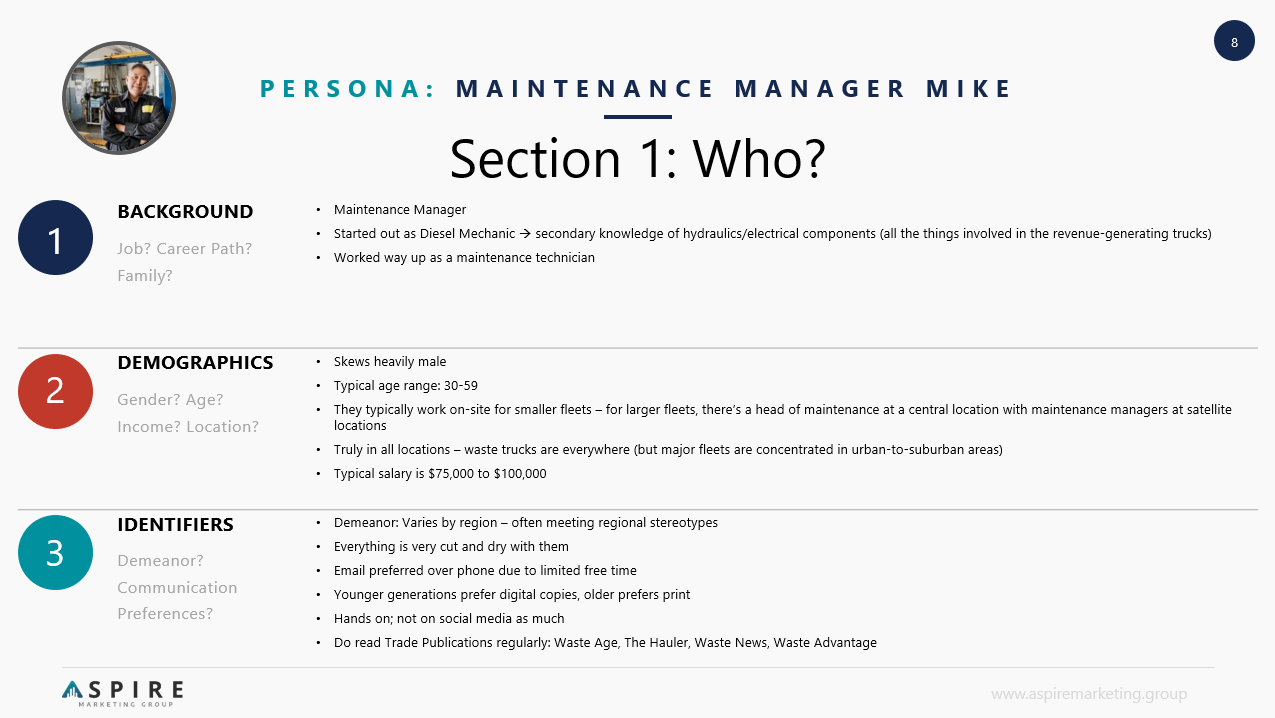You might be wondering, why do buyer personas matter? With detailed buyer personas, you can truly understand your customer. If you put yourself into the perspective of your audience, then you'll get a sense of their goals, challenges, even what they do during the day.
A detailed buyer persona is critical to a successful marketing strategy because you understand why they make buying decisions. They will also leave you with a handy and comprehensive target customer. Buyer personas helps dictate what content to produce, where to publish it, and more. It's an essential component in understanding how to obtain even more customers.
Aren't convinced you need to spend precious time mapping these personas out? Let's just say that 71% of companies who surpassed revenue and lead goals have documented personas.
But let's backtrack to lay down the potential-customer foundation. The buyer persona definition is simply this:
A buyer persona is a semi-fictional representation of your ideal customer based on market research and real data about your existing customers." – HubSpot
Can’t I Just Create a HubSpot Buyer Persona?
HubSpot is a software platform designed to house and manage your inbound marketing tools, contacts, and more. If you're a HubSpot user, then you know you can create buyer personas in the CRM property settings. This HubSpot functionality allows for your team to collaborate and define basic buyer personas together. If you've already created your buyer personas, HubSpot allows you to import them from a file.
There's also more to it than just having a few personas documented. With HubSpot, the buyer persona tracking and segmenting within your database is the most important benefit. HubSpot allows you to target these different groups and categorize your database contacts. That's why it's important to have a proper framework for creating and defining your buyer personas before you create them for tracking or segmentation purposes. If you slap some names and details down with no research to back them up, the persona won't help your core marketing strategy.
How is the B2B Buying Process Different from B2C?
There are often many decision makers in B2B, while in B2C there's usually only one, or at most, a few household members. Each key decision maker should be a different B2B buyer persona. You may want to focus on the ones who influence the purchase and do the research first, and then later build out the ones who play a role in the process.
For example, if selling human resource software, your first personas might be HR Managers and Directors. However, you may eventually build an effective B2B buyer persona for the IT Director — this person wouldn't go out seeking HR software, but they often do have the ability to say no and shut down a deal.
The B2B buying process is often much longer than B2C. There are often multiple decision makers, but because companies are more complex, there are potential blocks to a sale. Many levels of internal approvals are needed, and companies are slower to make decisions.
For example, for a manufactured B2B product, engineering might need to check the specs. Someone in purchasing may need to approve the cost, and a senior management team may need to review the purchase.
There is often more research involved in B2B purchases, and this should reflect in your buyer persona development process. The solutions tend to be more complex, and companies tend to require more due diligence before making a purchase. This is why inbound and content marketing are so impactful to educating and convincing your target audience.
What Makes Up A B2B Buyer Persona?
For a B2B persona, you need to gather various information about them. For example, you might collect their:
-
Online day-to-day behavior. Where do they hang out online during lunch breaks? Use a tool like Google Analytics to provide the answer.
-
Demographics, such as age and location. Don't forget your firmographic and technographic data!
- Psychographics, which is critical for market research as it classifies people according to their psychological data, or their moods and aspirations. One example is someone's personality or their values.
-
Goals, or what they need to accomplish in their work-life. You can also separate this into immediate and long-term goals.
-
Possible challenges they encounter, such as in their workflow or business strategy.
If you need help creating and strategizing your buyer personas, consider reaching out to a marketing agency for help.
Three Steps to Create a Buyer Persona
While buyer personas can vary dramatically between companies and industries, overall, they're not too complicated to develop. Here are the first three basic steps to make sure your marketing strategy is targeting the people you want to do business with:
-
Get into your buyer persona's headspace. What problems do they need help with, and what content will attract them?
-
Collaborate with sales and other departments. They can provide valuable insights, like who regularly buys your product or service. How would your persona experience your sales funnel?
-
Think about their personal and professional information. As stated above, you might brainstorm their internet behavior, personal characteristics, or search intent. If you already use a CRM, some of this data may already be readily available in your database.
While we often start off with internal assumptions and knowledge about our clients — and we encourage you to do the same — it is critical to treat your personas as a "living breathing" document that gets updated as you receive new knowledge. Because our own internal feelings are often biased, it's also important to seek outside validation of your personas, usually through interviews, surveys, and other kinds of outreach.
These three steps will have you up and running with a B2B buyer persona in no time.
B2B Buyer Persona Examples
What does a buyer persona actually look like? Let's create a sample B2B buyer persona to make sure the concept hits home. Remember, a buyer persona should describe a real person, not just a set of characteristics you've gathered.
Let's say you're in a product-focused sales team and you want to figure out who would be most interested in your offering.
First, start with a name. You might use a nickname like Maintenance Manager Mike. He might be an older maintenance technician. He could be frustrated with not getting parts fast enough or in an efficient manner. Below is how you could write out his details after discussing the potential buyer persona with your other departments. We've included a sample of the first page of a persona from our own buyer persona templates:

And you're done! You now have a very basic B2B buyer persona ready to use as the backbone of your inbound marketing strategy. The example above did not dive into all of his characteristics, but yours should. If you wanted to sell him a B2B product, how could your content be written to appeal to his demographic and what he values?
Now you have a core part of your marketing strategy checked off your enormous to-do list. However, remember to update your buyer persona details every six to twelve months as needed, whether they're in HubSpot or some other platform. This way you can ensure the content you're producing is relevant, knowledgeable, and will get the most attention.


0 Comments